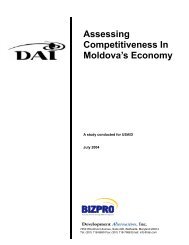Trade and Commercial Law Assessment - Honduras - Economic ...
Trade and Commercial Law Assessment - Honduras - Economic ...
Trade and Commercial Law Assessment - Honduras - Economic ...
Create successful ePaper yourself
Turn your PDF publications into a flip-book with our unique Google optimized e-Paper software.
TRADE AND COMMERCIAL LAW ASSESSMENT DECEMBER 2004<br />
HONDURAS<br />
c.<br />
♦ Management is seeking to create a new risk management system. Canadian Customs has<br />
provided training over the past 2 years with onsite visits <strong>and</strong> a 2-week course in Canada.<br />
Four analysts are currently assigned to the risk group <strong>and</strong> are performing some functions.<br />
However, Customs is still without official authority authorizing a risk management<br />
process.<br />
♦<br />
♦<br />
Post verification is well developed, with a staff of eight dedicated to Customs audits. This<br />
staff verifies approximately 3,600 transactions referred from field locations monthly <strong>and</strong><br />
finds errors in classification, value <strong>and</strong> some nonrevenue issues. Many of the discrepant<br />
declarations are referred for penalty. There is still a high broker/trader error rate, <strong>and</strong> the<br />
post verification group has collected more than $500,000 in additional revenue in the first<br />
8 months of this year. The Revenue Enforcement office performs customs <strong>and</strong> tax audits<br />
on company premises.<br />
♦ There is a system for h<strong>and</strong>ling restricted goods. Prohibited <strong>and</strong> restricted goods are<br />
identified in directives sent to field personnel indicating what permits <strong>and</strong> licenses are<br />
required to process such goods. The directives appear to be extensive <strong>and</strong> are also<br />
provided via electronic mail.<br />
♦ Automation efforts are improving. Puerto Cortez electronically receives more than 60<br />
percent of goods by value, <strong>and</strong> within the past month Customs has started a pilot program<br />
to electronically receive vessel manifests. Other sites are manually inputting bill data into<br />
the automated system <strong>and</strong> matching <strong>and</strong> verifying bill of lading data with the declaration.<br />
♦<br />
♦<br />
Customs is developing adequate capacity in valuation. It has received some value<br />
training, including training from the WTO in 2003 <strong>and</strong> has a value database of<br />
approximately 40,000 records that provide values for reference purposes. The Value<br />
branch is staffed by a group of seven analysts, who are responsible for updating the<br />
database <strong>and</strong> providing expertise to the field <strong>and</strong> for post verification.<br />
A ruling process is applied for h<strong>and</strong>ling classification issues. Four analysts are assigned<br />
to the classification function, including the ruling<br />
process. The ruling process is only for<br />
classification issues but is said to be binding on all sites.<br />
Customs Processing Sites: Toncontin, Las Manos, <strong>and</strong> Puerto Cortez<br />
The Toncontin inl<strong>and</strong> facility in Tegucigalpa provides an efficient operation with<br />
adequate hours, staff, systems, <strong>and</strong> security. The facility processes about 35,000<br />
declarations annually for air <strong>and</strong> inward cargo arriving from Puerto Cortez <strong>and</strong> l<strong>and</strong><br />
borders. The offices are small, but the cargo examination facility is sufficient, with good<br />
security, including cameras, guards, <strong>and</strong> cold storage facilities. All shipments are<br />
weighted <strong>and</strong> filmed on arrival. The operator of the facility, Swissport, indicated<br />
that<br />
there is little pilferage of goods, because of secure controls. All personnel working for<br />
Swissport are screened <strong>and</strong> wear identification badges that specifically authorize them<br />
to<br />
work in certain areas. The office operates from 8:30 a.m. to 4:30 p.m. <strong>and</strong> also processes<br />
some courier shipments. Officials stated that 60 percent to 80 percent of shipments are<br />
released without examination, while 20 percent to 40 percent undergo physical<br />
examinations. Most goods are released within 2–4 hours of the filing of the declaration,<br />
XI-6

















